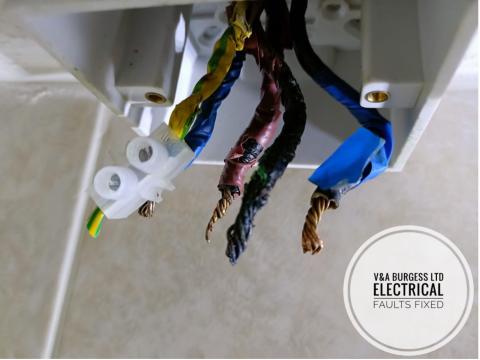
1) What causes a burnt cable?🔥
In an electrical system there is an electrical current within cables whenever there is a demand for power. The greater the power demand the greater the current flow through cabling. Occasionally there will be a larger than intended power demand causing an over current when, hopefully, the circuit breaker will turn off the circuit.
If there is too large a current demand for too long without the circuit disconnecting then the cabling will suffer as a result. Cables can overheat and burn if not protected by a circuit breaker or fuse wire. This is one of the way that a CABLE can become BURNT within and electrical installation.
Cables can also become burnt when:
- Arcing or sparking occurs between the conductors contained in the cable
- Short circuit happens
- Insulation covering the cables prevents the cable from dispersing its heat
- Heat is applied to the cable from poorly installed equipment like downlights, ovens etc
The list is not exhaustive.
Back to top2) What can be done?🤔
There are a number of things we can do to rectify burnt cables although if we do not also remove the source of the problem then it is likely the newly installed cables will, at some point, suffer the same fate!
It may be beneficial to subject the electrical installation in your home to a Periodic Electrical Inspection. This will highlight any further issues, test all circuits and allow you to have an overview of the condition of your installation and its suitability for continued use. Many of us live in homes where the electrical installation is several decades old, has not been maintained and is overdue repairs or rewiring. Electrical installations will not last forever and many can fail unexpectedly, normally when it is most inconvenient.
Back to top3) Is insulation bad for cables?⚠️
In a lot of cases, thermal insulation and cables should be absolutely kept separate. When your electrical system is designed before installation, the designer will specify how much power the cables can handle / how much electrical current they can carry before they begin to suffer damage and fail. When thermal insulation is put on top of cables, around cables or when cables have to pass through it there can be a detrimental effect on cabling and can cause a BURNT CABLE.
A cable generates heat in normal use and must be able to get rid of its heat somehow. Thermal insulation is fantastic at keeping heat in your home and also fantastic at keeping heat in a cable when the cables is covered. For that reason electrical designers will specify that cables must be kept away from thermal insulation as they can easily overheat creating a fire risk unless properly designed to withstand the effects of the insulation.
Back to top4) Are all cables affected?🔎
Yes but some cables are intended to be buried sometimes. For instance, these days in general, lighting circuits require such little electrical current / power that very little heat is generated and therefore it is normally okay to cover these cables with insulation. The issue tends to become more of a problem when larger and more powerful circuits and their cabling come into contact with thermal insulation. Sockets, cookers and electric showers are all heavy current using circuits and their wiring must be kept away from the insulation unless the circuit has been designed to withstand it.
If you are at all unsure of the cabling installed in your home and its capabilities then please contact us to come and inspect. If you have had loft insulation recently installed in your home and can not see any cables in your loft where previously they were visible then there is a chance your cabling and home is at risk.
It is a good idea to have a Periodic Electrical Inspection carried out if you believe there may be issues, pleas have a chat with us and tell us of your concerns as it may be necessary for us to inspect the loft cabling.
Back to top5) When can applied heat be a problem?🌡️
In some cases, downlights can create a lot of heat although these are improving as time goes on. A lot of downlights can give off heat and are recommended not to be covered with thermal insulation. When they are covered over there is nowhere for that heat to go and then this can create problems. Some manufacturers of modern downlights state it is acceptable if insulation covers their lighting and this will be stated in the manufacturers instructions for the product. This is one of the items we can check when performing an Electrical Inspection.
Heat and electrical installations can also come together where cooking or drying appliances are put together. When we consider an electric oven installation we have an appliance that can reach very high temperatures and electrical cables that can be exposed to those. Many times there are absolutely no problems and nothing to worry about but if you are at all concerned then ask us to inspect these when carrying out an inspection for you.
Back to top6) What happened to the wiring in the photograph?🔥
The CABLE in the photograph had been BURNT and damaged because there was an installation problem. We were called to the property because the consumer unit / fuse board was tripping and would not stay on. The homeowner informed us that there had been recent work carried out in the bathroom and upon further investigation we discovered the pull cord light switch had been incorrectly installed into the wrong surface box.
The installed of the pull cord had just ignored this fact and screwed the front on as tight as possible. This caused the Line conductor to press hard against the small earthing terminal which punctured the wiring and caused tiny little explosions to occur until the circuit disconnected. Joyful.
We found this and managed to repair the problem. New light switch installed correctly, tested and made safe. If you are concerned about your old, deteriorated wiring; get in contact with your local electricians in Liverpool.
Back to top









